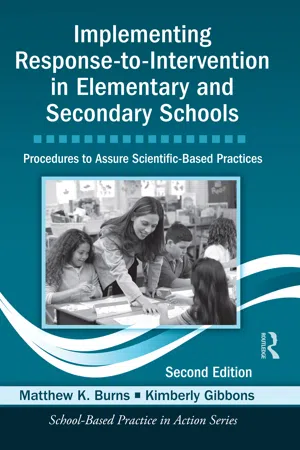
Implementing Response-to-Intervention in Elementary and Secondary Schools
Procedures to Assure Scientific-Based Practices, Second Edition
- 218 pages
- English
- ePUB (mobile friendly)
- Available on iOS & Android
Implementing Response-to-Intervention in Elementary and Secondary Schools
Procedures to Assure Scientific-Based Practices, Second Edition
About This Book
An update to the bestselling first edition, this practical guidebook for implementing a school-wide Response-to-Intervention (RTI) model clearly and concisely presents issues from assessment and decision-making to Tiers I, II, and III interventions. The authors discuss what RTI is and why it is used, how to conduct assessments within an RtI system, and how to create a school-wide organization to facilitate RTI. Curricula, instruction, and intervention strategies for each Tier level covered in detail, and answers to frequently asked questions and tips for getting started are also provided. Each chapter has been extensively revised and updated with the most current research and work in the field. New to this edition are a chapter on RTI in early childhood settings and a section in each chapter focused on considerations for secondary schools. The downloadable resources include forms, checklists, reports, and progress monitoring materials to assist practitioners in the implementation of interventions. With this valuable, practical resource, school-based practitioners will be able to put the information they read into action immediately to enhance the implementation of RtI services for their schools and students.
Frequently asked questions
Information
One
Response-to-Intervention: What It Is and Why We Do It
How We Got Here
Role of the Federal Government in Funding Special Education
Concerns About Special Education
Knowledge of Human Learning and Interventions
Accountability Movement
What Is it?
| Tier | Student Population | Description | Frequency of Assessment |
|---|---|---|---|
| | |||
| 1 | All Students | Universal: Adherence to a research-based core curriculum in general education. | Benchmark assessment at least three times/year. |
| 2 | Approximately 15% | Targeted: Small-group (three to five students) interventions delivered as part of general education. | At least monthly progress monitoring. |
| 3 | Approximately 5% | Intensive: Individualized interventions based on problem-solving models. Could include special education services. | At least weekly progress monitoring and frequent informal classroom-based assessments. |
Table of contents
- Cover
- Half Title
- Series Page
- Title Page
- Copyright Page
- Contents
- List of Illustrations
- List of Tables
- Series Editors’ Foreword
- About the Authors
- Chapter 1 Response-to-Intervention: What It Is and Why We Do It
- Chapter 2 Assessments Within an RtI System
- Chapter 3 Data-Based Decision Making
- Chapter 4 Schoolwide Organization to Facilitate RtI
- Chapter 5 Curriculum and Instruction for All Children: Tier 1
- Chapter 6 Intervention Strategies for a Selected Group: Tier 2
- Chapter 7 Intensive Interventions for Individual Students: Tier 3
- Chapter 8 Implementing the RtI Framework in Early Childhood Settings
- Chapter 9 Frequently Asked Questions Regarding Implementation and Tips for Getting Started
- References
- Index
- CD Contents